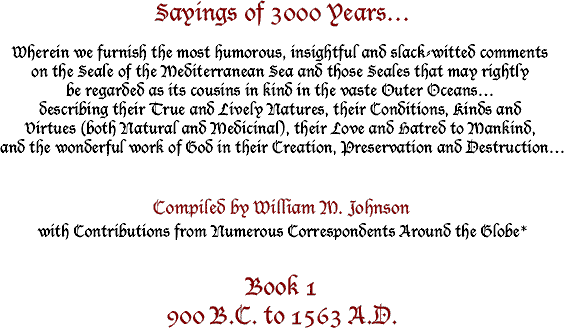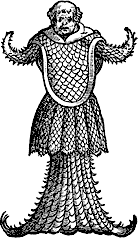 |
|
|
 |
||
 |
|
|
|
|
9th-8th Century B.C. The goddess answered: "So be it, stranger; I will tell you all without deceit. When the sun in its course has reached mid-sky, the sage old sea-god leaves his ocean – the west wind blows then, and the ruffled water is dark enough to hide him. Once ashore, he lies down to sleep under the arching caves, and around him is a throng of seals, the brood of the lovely child of Ocean; they too have come up through the grey waters, and they too lie down to sleep, smelling rankly of the deep brine below... First he will pass along all the seals and count them; then, having viewed them and made his reckoning, he will lie down among them all like a shepherd among his flock of sheep." ~ Homer, the Odyssey. |
545 B.C. The ‘Seal City’ of Phocaea (modern day Foca in Turkey) falls to the Persians. |
   |
|
|
5th Century B.C. "It is best to use a fumigation of seal oil: put the coals in a pot and wrap the woman up – except for her head. So that as much vapour as possible is emitted, drip a little fat on it, and have her inhale the vapour." ~ Hippocrates (c. 460-380 B.C.), De mulierum affectibus. |
|
|
4th Century B.C. Like human beings, it [the seal] bears at every season of the year, but especially at the time when the first goats are kidding. When the young are about twelve days old, it takes them down to the sea many times a day to accustom them to it gradually. To get down steep places it just lets itself go without attempting to walk, because it is unable to get a grip with its feet. It can contract and compress its own bulk, because it is soft and fleshy and its bones are cartilaginous. It is difficult to kill a seal by using force, unless you strike it on the temple, because its body is fleshy. It lows like a cow. In respect of its genital organ also the female resembles a cow; in all other respects it resembles the human female." ~ Aristotle (384-322 B.C.), Historia Animalium. |
336 B.C. The 19-year old Alexander the Great assumes the throne of Macedonia, succeeding his father, Phillip II. |
|
4th – 3rd Century B.C. The spotted lizard, they say, begrudging humans its helpful service, swallows down its skin after shedding it, because it is a remedy for the epileptic. And the stag buries its right horn, as it is effective against the poison of the toad... And that the seal, whenever it is about to be captured, vomits its rennet, which is also useful to epileptics... But animals don’t do these things because of a grudge; rather, humans, from their own characteristic way of seeing things, have ascribed to them this motivation – that is altogether clear. For from whence could irrational creatures have such great knowledge, which even rational beings acquire [only] with much practice? Rather, the seal is troubled and vomits its first milk probably through fear, and the spotted lizard swallows down its skin by virtue of an inclination that is natural to it... ~ Theophrastus (c. 371-287 B.C.), Fragmenta. |
|
|
1st Century A.D. Seals are with difficulty killed unless the head is shattered. Of themselves they make a noise like lowing, whence their names ‘sea-calves’; yet they are capable of training, and can be taught to salute the public with their voice and at the same time with bowing, and when called by name to reply with a harsh roar. No animal sleeps more heavily. The fins that they use in the sea also serve them on land as feet to crawl with… it is also said that the right fin possesses soporific influence, and when placed under the head attracts sleep. ~ Pliny the Elder (A.D. 23-79), Natural History.
~ Dioscorides Pedanius (c. A.D. 40-90), De materia medica. |
Christ crucified around A.D. 29. A.D. 77. Fish prices soar in Rome, possibly because of coastal overfishing. Pliny complains that one mullet equals the price of nine bulls. |
|
1st – 2nd Century A.D. As for Augustus’s superstitions: he is recorded to have been scared of thunder and lightning, against which he always carried a piece of seal-skin as an amulet, and to have taken refuge in an underground vault whenever a heavy storm threatened – because, as I have already mentioned, he had once narrowly escaped being struck on a night march. ~ Suetonius (c. A.D. 69-c.122) The Twelve Caesars. |
|
|
2nd Century A.D. For the Seal no hooks are fashioned nor any three-pronged spear which could capture it: for exceeding hard is the hide which it has upon its limbs as a mighty hedge. But when the fishermen have unwittingly enclosed a seal among the fishes in their well-woven nets, then there is swift labour and haste to pull the nets ashore. For no nets, even if there are very many at hand, would stay the raging seal, but with its violence and sharp claws it will easily break them and rush away and prove a succour to the pent-up fishes but a great grief to the hearts of the fishermen. But if betimes they bring it near the land, there with trident and mighty clubs and stout spears they smite it on the temples and kill it: since destruction comes most swiftly upon seals when they are smitten on the head. ~ Oppian of Cilicia, Halieutica.
~ Galen (c. A.D. 129-204) De alimentorum facultatibus. |
A.D. 166: Embassy from Emperor Marcus Aurelius reaches China |
|
2nd – 3rd Century A.D. The Seal, I am told, vomits up the curdled milk from its stomach so that epileptics may not be cured thereby. Upon my word the Seal is indeed a malignant creature. ~ Aelian (c. 170-235 A.D.) On the Characteristics of Animals. |
|
|
3rd Century A.D. And if we look at creatures in the sea, we need not wonder at the dolphins loving their offspring, for they are superior creatures; but shall we not admire the whales and seals and the viviparous species? For I once saw a seal that was kept shut up at Aegae in the circus, and she mourned so deeply for her whelp, which had died after being born in confinement, that she refused food for three days together, although she is the most voracious of animals. ~ Philostratus the Athenian, The Life of Apollonius of Tyana. |
|
|
4th Century A.D. Thus the power to rule everywhere, implanted by the Creator, is granted to man. Hence the swordfish and the hammer-headed sharks and the whales and the priones and the seals and all those fearful names of sea monsters have come under the command of man. ~ Gregorius Nyssenus (c. A.D. 335–394) De creatione hominis sermo primus.
~ Palladius, De re rustica. |
313 A.D. Emperor Constantine the Great decrees that all citizens must be allowed to worship freely. In succeeding decades, Christianity was established as Rome’s official religion. |
|
4th – 5th Century A.D. For how, tell me, shall he be able to cut down his passions, when the point is blunted, and bent back like a lead ruler? How shall he wound the Devil? And to whom is a man cultivating fleshiness not disgusting, crawling as he does after the manner of a seal? I am not speaking of those who are so by nature, but rather of those who make their bodies like this through luxuriousness, about those who are slim by nature. ~ Saint John Chrysostom (c. 347–407 A.D.) In Acta Apostolorum. |
360 A.D. Emperor Julian encourages revival of pagan religious beliefs to counter Christianity. |
|
5th Century A.D. Serapion also gives the [epileptic] patient camel’s brain and bile and seal’s rennet… Like the epileptics themselves, his treatment falls to the ground. ~ Caelius Aurelianus, On Acute Diseases & On Chronic Diseases.
~ Nonnus, Dionysiaca. |
465-1000 A.D. Europe falls into the Dark Ages |
 |
|
|
15th Century A.D. The number of sea wolves that come here [to Isla del Lobos in the Canary Islands] is astonishing, and every year might be got a sufficient quantity of skins and fat to fetch five hundred gold doubloons and more. ~ Bontier & Le Verrier, 1402
~ Gaspar Frutuoso, 1550 (On the Portuguese conquest of Madeira in 1419).
~ Eanes da Zurara, 1437 (On the Portuguese discovery of the Rio d’Oro, Western Sahara).
~ Hernando Colon, 1493. |
The Renaissance age, however, is also characterised by the tyranny of the Church, with millions being persecuted and put to death for alleged witchcraft and heresy. Despite religious persecution, the Renaissance is also a period of exploration, in which the Spanish and Portuguese vie with each other over conquests in Africa, and Christopher Columbus (1451-1506) accidentally stumbles across the New World. |
 |
|
|
16th Century A.D. Its hair is reputed to be of such a wondrous nature that the skins or belts are worn by mariners. When thunderstorms, tempests and other inclement weather is nigh, the hair shall rise and bristle, but when it turns still and mild, it shall lay down smoothly. ~ Konrad Gesner, 1563. Fischbuch. |
|
|